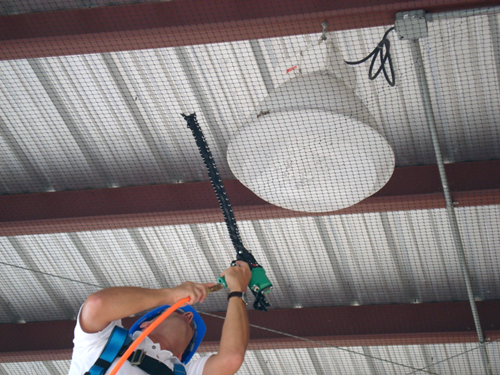by Alex A. Kecskes
There are songbirds, lovebirds and pet birds. And then there are pest birds. Birds we can all do without. Birds we don't want to harm--we just want them to stay away. One way to do that is the subject of this article.
Bird Netting for Facilities ManagersIf you're a facilities or plant manager, you undoubtedly know that pest birds can cost you a ton of money and aggravation . They can easily invade your aircraft hangar, factory or warehouse, gathering by the hundreds in eaves, canopies and other large covered areas. Support beams make ideal landing, roosting and nesting areas for these pest birds. If you don't keep them out with deterrents like bird netting, you'll have to contend with all sorts of problems.
One of the biggest problems with pest birds is bird droppings. Aside from being unsightly and unhealthy, droppings can stop up gutters and down pipes. They can also "freeze up" ceiling windows and vents, as well as rooftop turbine ventilators and siding windows. Bird droppings can eat into corrugated metal surfaces, cover light sensors and security cameras, even block out those new solar panels you just installed to save energy. In fact, the acid in bird droppings can eat into electrical equipment to create a fire hazard. If you manage a warehouse, bird droppings can spoil finished products in loading bays and storage areas. They can damage goods, and ruin the appearance of expensive finished goods. And something few facilities managers think about are slip-and-fall hazards created by bird droppings--this can become a costly legal liability should a worker or visitor become injured.
All the more reason you need an effective bird deterrent like
bird netting. The good thing about today's bird netting is that it's virtually invisible and blends in with the visual aesthetic of a structure's architecture.
Bird Netting For GrowersIf you're a grower or farmer, you've seen the damage pest birds can cause to cornfields, fruit orchards, and vineyards. How quickly they can attack blueberries and blackberries, and how they can invade barns, stockyards and chicken coops. And because you deal in food, you know that bird droppings, bird nests and the mites that infest them can present a health hazard, carrying and transmitting any of 60 known diseases. Sparrows and Feral Pigeons, for example, can carry bacteria causing Salmonellosis. Feral Pigeons carry Ornithosis, which resembles viral pneumonia. You may have heard about
bird netting, but you'd like to know more. If so, read on.
Bird Netting…Types and SizesSo what kind of bird netting should you get? The good news is, there's a
bird net for virtually every bird type and size. For large birds like pigeons and seagulls, you should go with a 1-1/8” to 2” mesh size. For smaller birds like sparrows and starlings, a smaller size in the area of 3/4" mesh would be best. Opt for ISO 1806 protocol mesh test netting for lasting strength. Some manufacturers will even custom cut the netting you need. Others offer U.V. stabilized, flame resistant and rot and waterproof netting. Not a bad idea if you install netting outdoors and leave it exposed to severe weather changes. You can get bird netting that can stand up to temperature extremes--from nets that have a flame resistant 250 degree F melting point to those that can tolerate "sub-zero" temperatures. Consider non-conductive netting in areas where electrical conductivity or radio frequency interference presents a problem.
For aircraft hangars, garages, factories, warehouses, and large canopies, you should go with
heavy-duty bird netting constructed of high strength polyethylene. If you're concerned about the appearance of netting and whether it will detract from your facility's architecture, not to worry. Today's bird netting comes in several colors, including white, stone and black. One note: Black bird netting won't discolor when it gets dirty or dusty. Installed properly, most bird netting is almost invisible. Resilient knotted polyethylene bird netting is available in U.V. treated twine for extended life. The burst strength on these nets can be as high as 40 pounds. Some manufacturers offer quality constructed bird netting that comes with a long guarantee--up to 10-years.
For growers,
bird netting can keep pest birds from wreaking havoc in the field. For best results, drape the net directly over the crop (or over the trees). You'll want to affix the net to a structure overhead, which will allow you to completely enclose your orchard or vineyard. One bit of advice here: Make sure you drape your nets high enough to prevent birds from sticking their beaks through to eat your crop.
One last thing to remember about bird netting. If you need to cover an airplane hangar, warehouse or any large area, you'll need thousands of square feet of netting and special lifts and power gear. This kind of job calls for a
professional bird control installer. If you don't install the bird netting properly, the net will sag and droop, leaving gaps for pest birds to sneak in.










